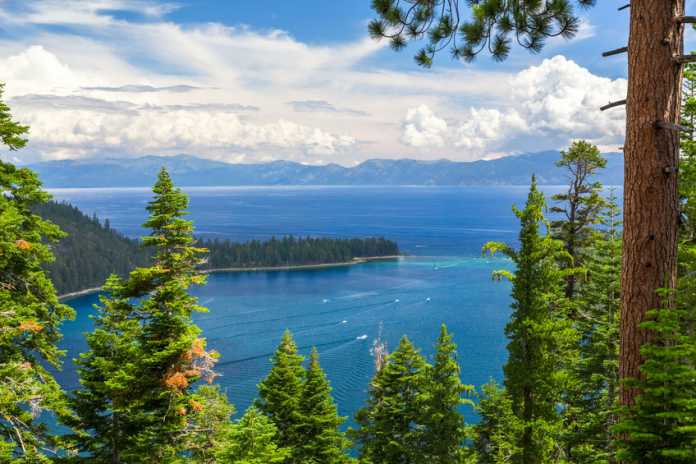Within the space of 24 hours news reports highlighted both that Lake Tahoe had fallen below its natural rim threatening water flows to the Truckee River and the Truckee-Carson Irrigation district, and that, in response to rain and snowfall in the region, the lake had risen above its rim once again, ensuring continued water flows for the time being. Both reports falsely link climate change to the recent rise and fall Lake Tahoe’s water levels. This shows their reporters either don’t understand or don’t care about the difference between climate and weather. Both reports also ignored the significant population growth in the region exploiting Lake Tahoe, making increasing demands on the natural body of water.
On Sunday, October 24, the Associated Press (AP) put a story on the wire, titled “Drought, climate change cause Lake Tahoe to dip below natural rim.”
“Drought fueled by climate change has dropped Lake Tahoe below its natural rim and halted flows into the Truckee River, an historically cyclical event that’s occurring sooner and more often than it used to — raising fears about what might be in store for the famed alpine lake,” said the AP’s story.
Then significant amounts of rain from a major west coast storm came and less than 24 hours later, The Week published a story picked up by Yahoo News, titled “Massive storm brings Lake Tahoe’s water levels back above natural rim.”
The Week reported:
“Heavy rain and snow fell in Northern California over the weekend — so much that Lake Tahoe’s water levels are back above the natural rim.
Water levels at the Tahoe City dam rose almost 6 inches in 24 hours, the U.S. Geological Survey said, and more than 24 inches of snow fell in the mountains around the Tahoe Basin.”
Drought in the region surrounding Lake Tahoe is not unusual and neither are wildly fluctuating lake levels. As an earlier Climate Realism post discussed, the Western United States is not experiencing a mega-drought as some reports claim. Indeed, current conditions are not outside the historic records of drought for the region.
As discussed in Climate at a Glance: Water Levels-Lake Tahoe as recently as 2019, water levels in Lake Tahoe were regularly exceeding its maximum allowable levels, forcing the the agency charged with managing water levels behind the dam on Lake Tahoe to release water from the dam. Indeed, Lake Tahoe reached the maximum allowable water level each year from 2017 through 2019, requiring special water releases into the Truckee River. See the figure.

Even the AP acknowledged Lake Tahoe’s water levels have declined below its rim multiple times in the past, for varying periods of time, writing:
“The lake dropped below the natural rim at an elevation of 6,223 feet (1,897 meters) twice in the 1920s after the dam was completed in 1913 and created the capacity to store up to 6 feet (1.8 meters) of water above the lake’s natural surface.
The level fell below the rim a half dozen times during the Dust Bowl in the 1930s, but not again until 1961, followed by 1977 and 1988. Since then, it’s happened nine times — six since 2004.”
To be clear, by the AP’s own accounting, Lake Tahoe’s water levels dipped below its rim six times in one decade, the 1930s—the most in any single decade—nearly 100 years of global warming ago. This was decades before human greenhouse gas emissions began to significantly rise.
What has changed since then and is likely contributing to Lake Tahoe’s current water woes is population growth in the region. Although population growth slowed during the decade from 2010 to 2020, in the late 1990s and the first decade of the 21st century, population growth and the number of people exploiting Lake Tahoe’s resources grew substantially.
According to one report:
“An interim Census report reveals significant growth in the counties surrounding Lake Tahoe.
El Dorado County experienced a 4 percent increase in population in one year, with 162,586 residents recorded by the U.S. Census Bureau last July. According to the 2000 Census, South Lake Tahoe grew 9.4 percent in a decade to 23,609 residents. El Dorado’s population surged 24.1 percent, with most of the growth on the west slope bordering Sacramento.”
As a result, the Sacramento Bee reported back in 2015 that the region’s population was on the verge of outstripping its water supply. Nowhere in either story do the reporters discuss the impact of population growth in the region on Lake Tahoe’s water levels.
The main flaw in these stories is that they conflate weather with climate. Drought is a weather phenomenon, only becoming an indicator of climate change if it persists for 30 years. The classical period is 30 years, as defined by the World Meteorological Organization (WMO). The two reporters are confusing weather and climate. The National Oceanic and Atmospheric Administration (NOAA) defines it well:
“Weather reflects short-term conditions of the atmosphere while climate is the average daily weather for an extended period of time at a certain location. … Weather can change from minute-to-minute, hour-to-hour, day-to-day, and season-to-season.”
That’s just what happened in Lake Tahoe over the weekend as precipitation took the Lake’s water levels back over its natural rim.
No region of the United States is experiencing an extended period of drought, indicating climate change, as the U.S. Environmental Protection Agency (EPA) noted in its Climate Change Indicator series, titled “Climate Change Indicators: Drought.”
Dire warnings of impending doom for Lake Tahoe from climate change may make newspaper selling headlines in the run of the U.N. Climate Conference (COP-26) in the beginning Glasgow, Scotland on October 31. However, they don’t reflect what science actually says about the causes of fluctuating water levels in Lake Tahoe. History shows they are entirely natural. Sadly, once again the press ignored the facts in an effort to push climate alarm.
















